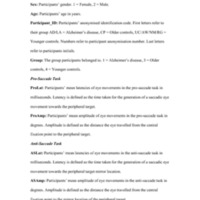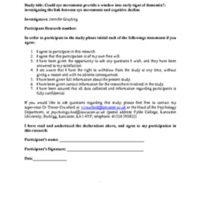Could eye movements provide a window into early signs of dementia? Investigating the relationship between eye movements and cognitive decline.
Dublin Core
Title
Could eye movements provide a window into early signs of dementia? Investigating the relationship between eye movements and cognitive decline.
Creator
Jennifer Grayling
Date
2017
Description
Past research has indicated a relationship between eye movement abilities and cognitive decline. Specifically, performances on the anti-saccade task and pro-saccade task have demonstrated a correlation with Alzheimer’s disease (AD) severity, suggesting that impairments in visual ability may be a potential biomarker for dementia. However, little research has investigated whether the same deficiency is present in more ecologically valid tasks. The current study therefore aimed to extend the dementia literature by examining eye movement abilities in individuals with AD when completing a task that required the visual exploration of videos. In order to investigate a disease effect, patients with AD were compared to healthy older controls. To explore age effects, the older controls were additionally compared to healthy younger controls. To attempt to replicate previous findings, all groups first completed both the pro-saccade and anti-saccade task, before subsequently completing a video task designed to require similar abilities as those necessitated by the anti-saccade task. The findings revealed clear qualitative differences between the age effect and the disease effect on the anti-saccade task, suggesting that AD is not purely an accelerated form of ageing. Furthermore, the results supported the contemporary literature, in that, patients with AD made more errors, and less corrected errors, on the anti-saccade task. In turn, these results advocate for the utilisation of the task as a biomarker of AD. However, this impairment did not translate to the videos task. These results suggest that certain conditions may be conducive to normal viewing behaviour in patients with AD, and thus may potentially indicate that the natural exploration of videos is not a reliable biomarker for AD.
Subject
saccades
Alzheimers
Alzheimers
Source
For all saccade tasks, a repeated measures design was used, with group as the independent variable (AD, OC, and YC). For the PST there were 2 dependent variables: latency and amplitude (see appendix A for definitions). For the AST there were 5 dependent variables latency, amplitude, number of errors, corrected errors percentage, and corrected errors start time (see appendix B for definitions).
For the videos a 3(Group: AD, OC, YC) x 2(Instructions: free view, instructed view) mixed design was used, with group as a between-subjects factor and instructions as a within-subjects factor. For each of the videos, dwell time was calculated as the dependent variable. A total of 25 AD, 17 OC and 37 YC completed the video task.
Materials
Eye tracking apparatus. An EyeLink Desktop 1000 eye-tracker was used at 1000Hz to record eye movements. Participants sat approximately 55cm away from the screen with their head on a chin rest to minimise movement. A 3x3 grid of sequentially appearing dots was used to calibrate participant’s dominant eye with the machine.
Pro-saccade task. The PST provides a measure of involuntary responses to visual stimulus. The methods utilised in this study followed previously established procedures (Crawford et al., 2005). In order to centre the participant’s gaze, the trial commenced displaying a central fixation target for 1000 milliseconds. This target then disappeared for 200 milliseconds, before a peripheral target appeared for 2000 milliseconds either to the left or right of the initial central fixation target (at ± 4°). The direction was randomised in order to avoid predictive saccades. The inter-trial interval then took place for 1200 milliseconds. The next trial began when the central fixation point reappeared. The participant’s task was to look at the peripheral target as quickly and accurately as possible (see appendix C). There were 36 trials in total.
Anti-saccade task. The AST provides a measure of inhibition. The task format was identical to the PST except here the participants were instructed to look as quickly as possible to the area, equidistant, but in the opposite direction to the peripheral target (mirror image) (see appendix D). There were 24 test trials in total and 4 practice trials.
Video task. The video task required participants to watch four, 40 seconds long videos. Three of the videos were viewed three times by participants and consisted of clips from past events in history: the coronation of Queen Elizabeth II, Neil Armstrong landing on the moon, and Gordon Brown and his family leaving Downing Street after losing the general election. Prior to each viewing of the video, participants were given different instructions relating to the video. On first viewing participants were instructed to freely watch the video, this was in order to elicit a bottom-up control of eye gaze to highly salient objects. On second viewing participants were asked questions relating to non-salient objects in order to elicit a top-down control of eye gaze.
The fourth video, an advertisement for Hovis bread, was viewed only once by participants. Participants were asked to follow with their eyes one object for the entirety of the video. Full details of the questions are given in Appendix E.
Procedure
The experiment took place in a well-lit room with no distractions that may have garnered attention. Participants firstly received an information sheet that briefly explained the study (see appendix F). All participants then signed a consent form (see appendix G) to formally provide their consent to take part.
Before each of the saccade tasks, participants were given time to ask any questions they had. Once they confirmed they understood the experiment, the test trials began. All groups completed the eye-tracking tasks in a pre-defined order. The PST was completed first to avoid carry-over effects previously reported by Roberts et al. (1994), followed by the AST, and lastly the videos task. Participants were offered breaks in-between each task to ensure they did not become distracted or bored. It took no longer than 45 minutes to complete all tasks. Once the experiment had finished, participants were handed a debrief sheet explaining the aims of the study (see appendix H).
Analyses
To analyse the videos, total dwell times to the question relevant interest areas were compared to total dwell times to these interest areas when the participants viewed the same video freely. For example, to analyse the trial were participants were asked to count the windows when viewing the Gordon Brown video, a number of interest areas were created around the windows (see appendix I). The total dwell times inside these areas were then compared to the total dwell times inside these areas when participants viewed the same video freely.
For the videos a 3(Group: AD, OC, YC) x 2(Instructions: free view, instructed view) mixed design was used, with group as a between-subjects factor and instructions as a within-subjects factor. For each of the videos, dwell time was calculated as the dependent variable. A total of 25 AD, 17 OC and 37 YC completed the video task.
Materials
Eye tracking apparatus. An EyeLink Desktop 1000 eye-tracker was used at 1000Hz to record eye movements. Participants sat approximately 55cm away from the screen with their head on a chin rest to minimise movement. A 3x3 grid of sequentially appearing dots was used to calibrate participant’s dominant eye with the machine.
Pro-saccade task. The PST provides a measure of involuntary responses to visual stimulus. The methods utilised in this study followed previously established procedures (Crawford et al., 2005). In order to centre the participant’s gaze, the trial commenced displaying a central fixation target for 1000 milliseconds. This target then disappeared for 200 milliseconds, before a peripheral target appeared for 2000 milliseconds either to the left or right of the initial central fixation target (at ± 4°). The direction was randomised in order to avoid predictive saccades. The inter-trial interval then took place for 1200 milliseconds. The next trial began when the central fixation point reappeared. The participant’s task was to look at the peripheral target as quickly and accurately as possible (see appendix C). There were 36 trials in total.
Anti-saccade task. The AST provides a measure of inhibition. The task format was identical to the PST except here the participants were instructed to look as quickly as possible to the area, equidistant, but in the opposite direction to the peripheral target (mirror image) (see appendix D). There were 24 test trials in total and 4 practice trials.
Video task. The video task required participants to watch four, 40 seconds long videos. Three of the videos were viewed three times by participants and consisted of clips from past events in history: the coronation of Queen Elizabeth II, Neil Armstrong landing on the moon, and Gordon Brown and his family leaving Downing Street after losing the general election. Prior to each viewing of the video, participants were given different instructions relating to the video. On first viewing participants were instructed to freely watch the video, this was in order to elicit a bottom-up control of eye gaze to highly salient objects. On second viewing participants were asked questions relating to non-salient objects in order to elicit a top-down control of eye gaze.
The fourth video, an advertisement for Hovis bread, was viewed only once by participants. Participants were asked to follow with their eyes one object for the entirety of the video. Full details of the questions are given in Appendix E.
Procedure
The experiment took place in a well-lit room with no distractions that may have garnered attention. Participants firstly received an information sheet that briefly explained the study (see appendix F). All participants then signed a consent form (see appendix G) to formally provide their consent to take part.
Before each of the saccade tasks, participants were given time to ask any questions they had. Once they confirmed they understood the experiment, the test trials began. All groups completed the eye-tracking tasks in a pre-defined order. The PST was completed first to avoid carry-over effects previously reported by Roberts et al. (1994), followed by the AST, and lastly the videos task. Participants were offered breaks in-between each task to ensure they did not become distracted or bored. It took no longer than 45 minutes to complete all tasks. Once the experiment had finished, participants were handed a debrief sheet explaining the aims of the study (see appendix H).
Analyses
To analyse the videos, total dwell times to the question relevant interest areas were compared to total dwell times to these interest areas when the participants viewed the same video freely. For example, to analyse the trial were participants were asked to count the windows when viewing the Gordon Brown video, a number of interest areas were created around the windows (see appendix I). The total dwell times inside these areas were then compared to the total dwell times inside these areas when participants viewed the same video freely.
Publisher
Lancaster University
Format
data/SPSS.sav
Identifier
Grayling2017
Contributor
John Towse
Rights
Open
Relation
This is part of an on-going EPSRC funded MoDEM study approved by the NHS to Dr Crawford
Language
English
Type
Data
Coverage
LA1 4YF
LUSTRE
Supervisor
Trevor Crawford
Project Level
MSc
Topic
Cognitive Psychology
Neuroscience
Neuroscience
Sample Size
33 participants diagnosed with AD by the NHS (age range = 59-90 years; Mage = 74.48; SDage = 8.16; females = 14; males = 15) were recruited through NHS trust sites, and 92 healthy OC (age range = 48-83 years; Mage = 67.66; SDage = 8.92; females = 31; males = 13) were recruited through a local church.
Statistical Analysis Type
ANOVA
Files
Collection
Citation
Jennifer Grayling, “Could eye movements provide a window into early signs of dementia? Investigating the relationship between eye movements and cognitive decline.,” LUSTRE, accessed December 16, 2025, https://www.johnntowse.com/LUSTRE/items/show/39.


